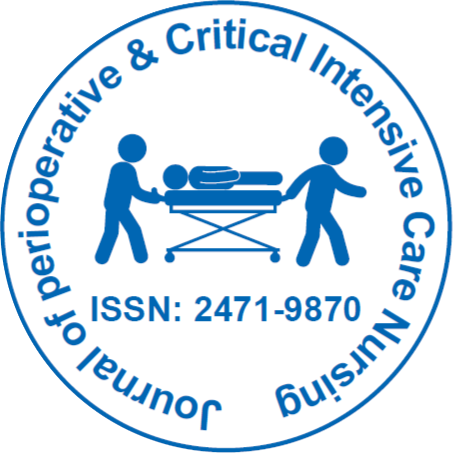
Journal of Perioperative & Critical Intensive Care Nursing
Open Access
ISSN: 2471-9870
+44-77-2385-9429

ISSN: 2471-9870
+44-77-2385-9429
Commentary - (2024)Volume 10, Issue 3
Patient monitoring is a fundamental aspect of healthcare that involves the continuous assessment of a patient’s vital signs, physiological parameters and overall health status. This practice is important for detecting changes in a patient’s condition, enabling timely interventions and improving outcomes. With advancements in technology, patient monitoring has evolved significantly, integrating sophisticated tools and methodologies that enhance the quality of care. The concepts, tools and importance of patient monitoring in modern healthcare environments are examined in this article.
Importance of patient monitoring
Effective patient monitoring is essential for various reasons. It allows healthcare providers to track vital signs such as heart rate, blood pressure, respiratory rate and temperature, which are critical indicators of a patient’s health status. Continuous monitoring can identify early signs of deterioration, allowing for prompt intervention that can prevent complications and improve survival rates. Additionally, monitoring supports clinical decision-making, guiding healthcare professionals in adjusting treatment plans based on real-time data.
In critical care settings, such as the Intensive Care Unit (ICU), continuous patient monitoring is paramount. Patients in these environments often have complex health issues that require close observation. The ability to continuously assess their condition allows for rapid responses to changes, ensuring that the highest standard of care is maintained.
Technologies in patient monitoring
These technologies cover all kinds of advances, such as:
Vital signs monitors: Traditional vital signs monitors are a staple in patient monitoring, providing real-time data on essential parameters. These devices measure heart rate, blood pressure, oxygen saturation and respiratory rate. Modern monitors often come equipped with alarm systems that alert healthcare providers to abnormal readings, enabling quick responses to potentially life-threatening situations. Furthermore, by using artificial intelligence and predictive analytics, alarm systems can be improved even further, assisting in the early detection of patterns and possible problems.
Remote monitoring: Advancements in technology have paved the way for remote patient monitoring, which allows healthcare providers to track patients' health from a distance. Smartwatches and fitness trackers are examples of wearable technology that can monitor vital signs and provide information to medical specialists. This approach is particularly beneficial for managing chronic conditions, as it empowers patients to engage in their health management while providing clinicians with valuable insights.
Telehealth integration: The delivery of healthcare has been significantly improved by the use of telehealth services into patient monitoring. Through virtual consultations and remote monitoring tools, healthcare providers can assess patients' conditions without the need for in-person visits. This is especially important for patients with mobility challenges or those living in remote areas. Telehealth not only improves access to care but also fosters continuity in monitoring, ensuring that patients receive appropriate follow-up.
Role of data analytics
With the vast amounts of data generated from patient monitoring systems, data analytics plays an important role in improving patient care. Advanced analytics can identify patterns and trends in patient data, helping healthcare providers make informed decisions. Predictive analytics, for instance, can assess the likelihood of complications based on historical data, enabling proactive interventions. This data-driven approach enhances clinical outcomes and optimizes resource allocation within healthcare settings.
Patient-centred monitoring
Effective patient monitoring goes beyond simply collecting data; it also involves engaging patients in their care. Educating patients about the importance of monitoring their health empowers them to take an active role in their treatment. Patientcentered monitoring approaches, which include regular feedback and discussions about monitoring results, can improve adherence to treatment plans and enhance overall satisfaction with care. By fostering open communication and encouraging patients to voice concerns, healthcare providers can build trust and strengthen the therapeutic relationship. This collaborative approach not only enhances patient outcomes but also contributes to a more complete understanding of their health needs.
Patient monitoring is an integral part of healthcare that significantly impacts patient outcomes and safety. With advancements in technology, the methods and tools available for monitoring have expanded, allowing for more comprehensive and continuous assessments. By leveraging these technologies and emphasizing patient-centered approaches, healthcare providers can enhance the quality of care, improve patient engagement and ultimately lead to better health outcomes. As the landscape of healthcare continues to evolve, effective patient monitoring will remain a foundation of safe and effective medical practice.
Citation: Aalyn K (2024). Patient Analysis: Improving Safety and Care in Medical Conditions. J Perioper Crit Intensive Care Nurs.10:257
Received: 27-Aug-2024, Manuscript No. JPCIC-24-34551 ; Editor assigned: 29-Aug-2024, Pre QC No. JPCIC-24-34551 (PQ); Reviewed: 12-Sep-2024, QC No. JPCIC-24-34551 ; Revised: 19-Sep-2024, Manuscript No. JPCIC-24-34551 (R); Published: 26-Sep-2024 , DOI: 10.35248/2471-9870.24.10.257
Copyright: © 2024 Aalyn K. This is an open-access article distributed under the terms of the Creative Commons Attribution License, which permits unrestricted use, distribution, and reproduction in any medium, provided the original author and source are credited